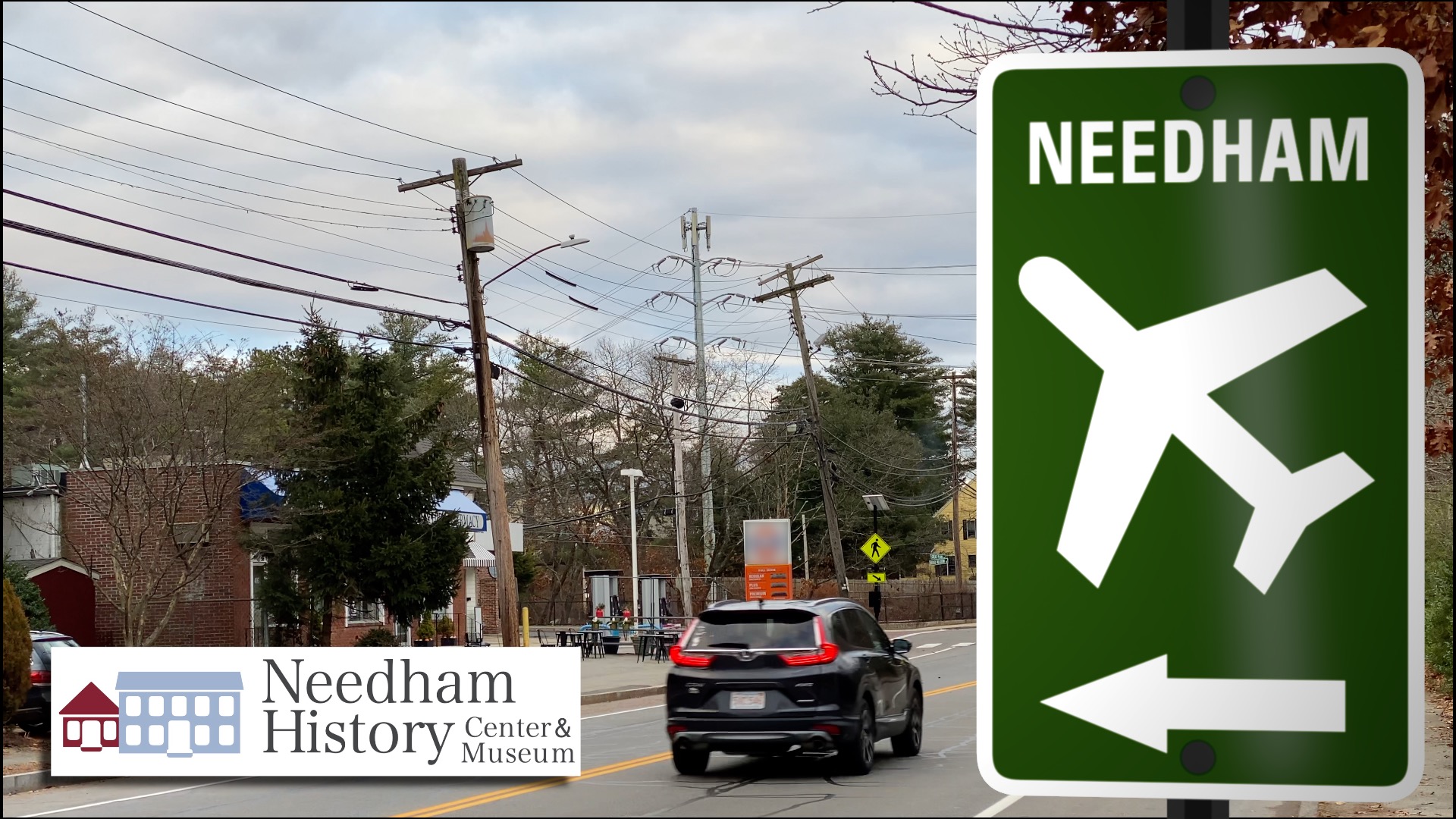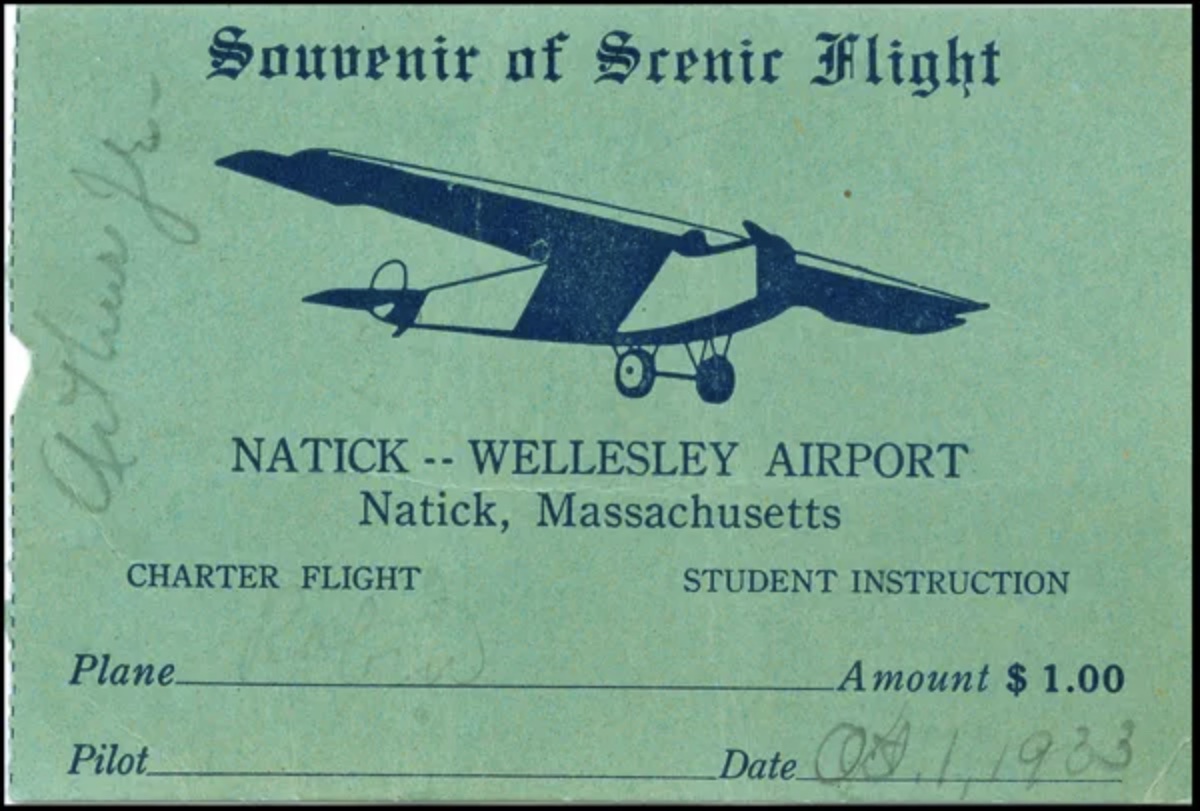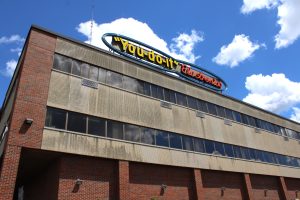
Needham History: Fly Needham!
It seemed like a good idea – but it is hard to know, nearly 80 years later, whether a Needham municipal airport would have been successful, or whether it would have been a boon or a curse.

“A Souvenir of Scenic Flight” from the Natick-Wellesley Airport. Inscribed “Arthur, Jr.” and dated October 1, 1933.
Fly Needham!
My previous car, a Nissan Altima, was purchased and serviced at Clay Nissan on Route 1 in Norwood. Clay is at the top of a hill, and from the parking lot you can get an excellent overview of the Norwood Airport. Despite its small size, flights of private planes and other small craft out of Norwood are fairly frequent, and it is common to see one of them taking off or coming in for a landing as you drive down Route 1.
This could have been us, too.
The notion of an airport in Needham is not as strange as it might sound. The later 1920s saw a major expansion in civil aviation. The technology that featured so romantically in World War 1 lore became available for more public use. Investors were attracted, and several of the small local airfields were built around this time – Norwood Airport opened in 1931; Barnstable County opened in 1928. There are still about 20 general and public (non-military) airfields in Massachusetts, and about twice as many that have closed over the years.
Even closer than Norwood, there was once an airfield in Natick. The Natick-Wellesley Airport opened in 1931. It was located in the vicinity of the Route 9–Route 27 interchange, roughly where MathWorks is now located. A group of Boston investors, the Natick and Wellesley Airport Corporation, sought permission to apply for a federal license to operate the airport, which would fly between Boston, New York, and “points west.” In addition, it would be a source of employment for the local area – an important enticement as the Depression took hold. There was some concern about cars congregating on Worcester Street (Route 9) to watch the planes, so the owners provided for an enclosed parking lot sufficient for 200 cars to accommodate plane-watchers, especially in the event of stunt flights – which could be permitted, though was not expected to happen often. Over the next couple of years, the airport became a location for pilot training, air shows, charter trips, scenic flights, aerial photography, repair shops, and more.
But with all the activity came controversy. People began to object to the flyover noise. Proposals in 1934 for Natick to take over and/or expand the airport met with citizen opposition and were defeated. In 1935, the Selectmen banned circuses, air shows, stunt flying, and the airport loudspeaker. In 1936, there is some evidence that the field was used to land planes smuggling illegal goods. Finally, in January 1937, the bank foreclosed on the investors, and the field closed for good.
It was against this background that discussions of an airstrip in Needham took place. The idea was first raised in the 1930s. It was probably raised and definitely supported by Leslie Cutler, Selectwoman, State Representative, State Senator, and Needham resident. Cutler was a trained pilot herself, and greatly interested in the economic potential of civil aviation. I have heard (but cannot verify) that there was interest in building the airstrip in the fields surrounding what is now Olin College. The War intervened, however, and the proposal had to be put aside.
In March 1945, an article on the Town Meeting warrant called for the formation of a committee “to investigate the advisability of establishing a public landing field for aircraft and a suitable site therefore.” The article passed, and the committee was formed; it also held joint meetings with members of similar committees in Newton and Wellesley. The two other towns decided not to move forward, but Needham identified two possible sites for development: (1) the swampland bounded by Great Plain Avenue, Central Avenue, and Charles River Street – now the site of the Ridge Hill Reservation, the RTS, the Newman School, the Needham History Center, and the Eastman Conservation Area; and (2) the McNamara Gravel Pit site – currently the site of the Industrial Center/Innovation District, east of Route 128.

The cost of the project was estimated at $150,000-250,000 (approximately $2.5-4.5M today), but it was hoped that the federal government would provide around half of the cost. The cause was championed in the General Court by Leslie Cutler, who at that time was a State Representative and the Chair of the MA House Committee on Aeronautics. Nevertheless, no groups or companies showed any interest in operating an airport in Needham. In 1946, the committee reported to Town Meeting again, but noted that there was no progress. They suggested that they delay providing a final report and continue “to further study the matter and keep close touch with any developments.” However, by 1947, no developments had developed. In the absence of progress and in view of the evident lack of interest, they concluded that there was “no further purpose” for continuing, and recommended that the committee and the project be terminated. Town Meeting agreed, and the project died there.
It is hard to know, nearly 80 years later, whether a Needham municipal airport would have been successful, or whether it would have been a boon or a curse. Norwood’s airport has been in business for more than 90 years. Natick’s lasted for only six. Both opened in 1931, under the same dire economic conditions of the early Depression. So who knows? One thing I do know, however, is that Needham has benefitted from the subsequent projects on these properties. The first site not only provide a remote-enough area for the town dump, but also the campus for a school (and a History Center!) and two treasured public recreation areas. The second site was developed into a roadway and a business area that has been an engine of economic development, revenue, and innovation.
[For the information about the Natick-Wellesley Airport, I am indebted to Bob Worthington, former Board member of the Natick Historical Society, whose article “Recalling When Natick had an Airport,” was published in the Natick Bulletin & Tab on 21 October 2016. Online at https://www.wickedlocal.com/story/bulletin-tab/2016/10/21/recalling-when-natick-had-airport/24728421007/
 |
Gloria Polizzotti Greis is the Executive Director of the Needham History Center & Museum. For more information, please see their website at www.needhamhistory.org. |

